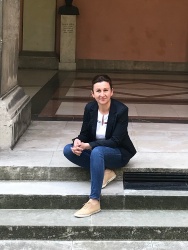Ana Sima
- Research fellow, Masaryk Institute and Archives, Czech Academy of Sciences
- Research Interests: Transylvania’s modern history; church history and the relationship between the Romanian Greek-Catholic Church and the Holy See in the second half of the 19th century and the early 20th centuries; history of education; cultural history of World War One
- Role in the project: Data extraction and analyses for the Romanian MPs between 1867–1918, Dissemination activities and scientific publishing
A short family history
The Ciocaș Family from Cărpiniș (Transylvania)
On the paternal line, the roots of my family go back the middle of the seventeenth century. At that time, Akos Barcsay, the Prince of Transylvania, elevated Simeon Ciocaş (Csokás, as it was spelled back then), to the rank of Noble of Cărpiniș (spelled Gyertyános), as a reward for his military merits.[1] This noble title enabled him to rise above the ranks of the Romanian serfs and to own small plots of land in his native village, Cărpiniș (Gyertyános), in northwest Transylvania. To this day, the Ciocaș family have remained anchored within the borders of Cărpiniș village, where they established themselves as local petty nobles (called nemeși) and owners of land, with lots they have expanded over the centuries through purchases, pledges and matrimonial alliances.[2]
Beginning in the nineteenth century, amidst the political, social and cultural changes in Transylvania, some of the descendants of the Ciocaș family were impoverished, while others turned to different professions, becoming priests and teachers in the Romanian Orthodox villages in the area. For example, in the middle of the 19th century, Grigore, one of the sons of the noble Zaharia Ciocaș attended the Faculty of Theology in Sibiu and became a priest in the neighboring town of Făureşti, as well archpriest of Cetatea de Piatră.[3] His brother, Vasile Ciocaş, also chose the clerical path and became a priest, first in his native village, Cărpiniș,[4] and later, in the neighboring village, Cărbunari.[5] In the families of the two, the priesthood was “inherited” for two more generations, either through their sons, who became priests, or through their daughters, married to future priests.










